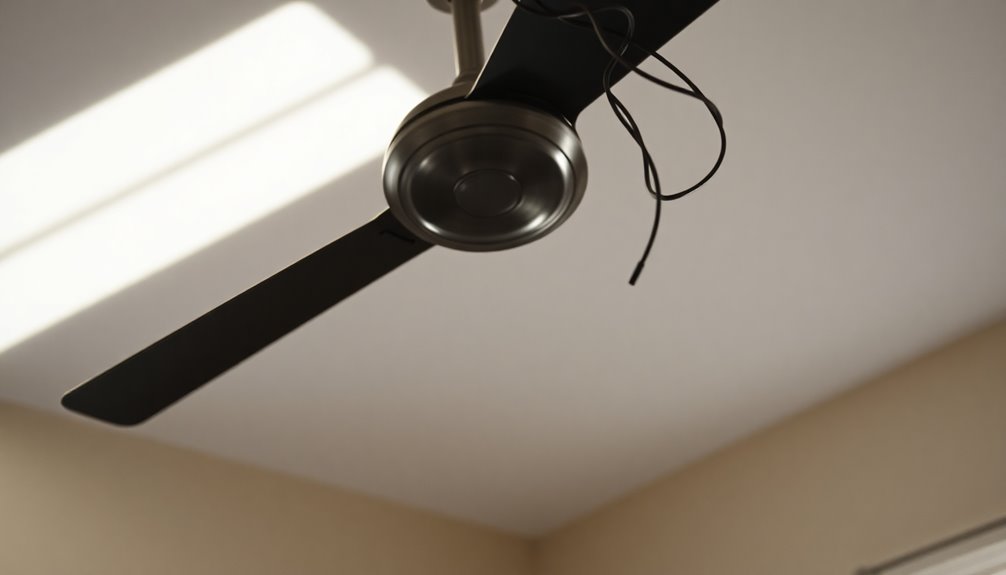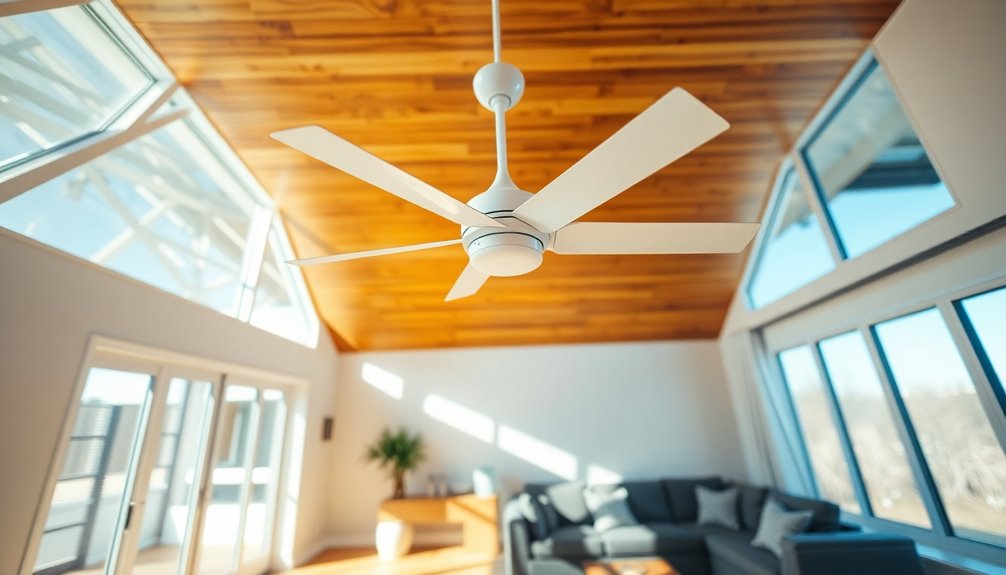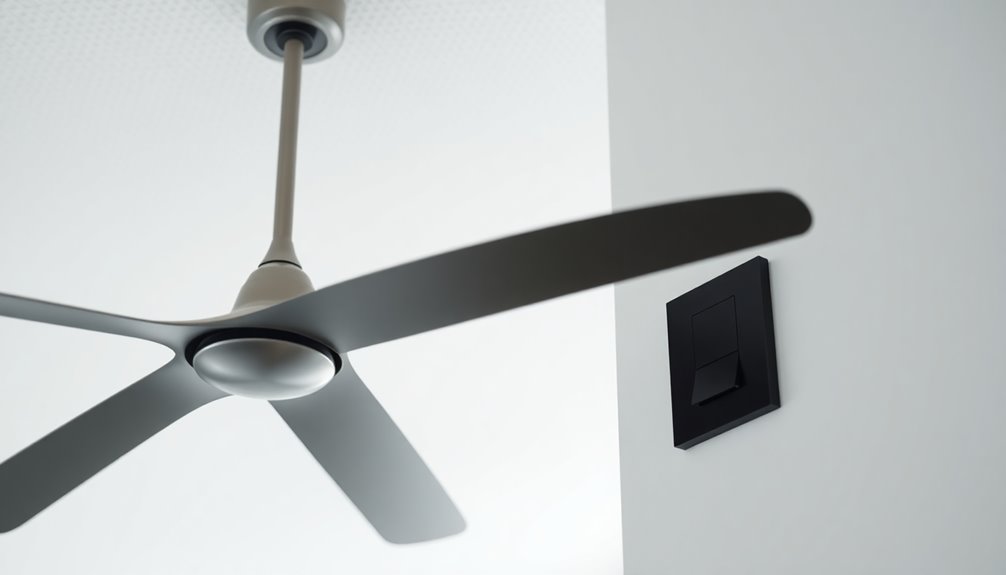If your ceiling fan isn't spinning fast, several issues might be at play. A faulty capacitor often leads to significant drops in speed, while dust buildup on the blades can restrict airflow. You should also check for unbalanced or damaged blades, as these can hamper performance. Inspect the motor bearings for dirt or wear and guarantee proper lubrication. Finally, verify your power supply is consistent with no loose wiring. Addressing these factors can greatly improve your fan's efficiency. There's more to uncover about fan maintenance and troubleshooting techniques that can keep your fan running efficiently.
Key Takeaways
- A faulty capacitor is a primary cause of low fan speed, affecting motor power transfer significantly.
- Dust accumulation on blades restricts airflow, leading to reduced spinning speed.
- Unbalanced or damaged blades can decrease RPM and overall fan performance.
- Old or dirty motor bearings increase friction, hindering smooth operation and speed.
- Electrical issues, such as insufficient power supply or loose wiring, can result in slower fan speeds.
Common Causes of Low Speed

Experiencing low speed with your ceiling fan can be frustrating, but understanding the common causes can help you troubleshoot the issue effectively.
One major culprit is a faulty capacitor, which accounts for about 90% of fan speed problems. This component is vital for transferring power to the motor, and when it fails, you'll notice a significant drop in speed.
Another factor is dust accumulation on the blades; even a small layer can greatly hinder airflow.
Unbalanced or damaged blades can also create inefficiencies, reducing the RPM and impacting overall performance.
Old or dirty motor bearings introduce friction, further affecting fan speed and functionality.
Electrical issues, like insufficient power supply or loose wiring connections, can lead to slower fan speeds, so it's important to inspect these thoroughly.
Finally, installation errors, such as improper mounting or misalignment, can cause wobbling and inefficiency, ultimately compromising your fan's performance.
Troubleshooting Steps

When your ceiling fan isn't performing as it should, start by inspecting the power supply to guarantee it's getting enough voltage.
Next, check the condition of the blades and listen for any unusual sounds that might indicate motor issues.
Inspect Power Supply
Inspecting the power supply is an essential first step in troubleshooting ceiling fan issues. Start by confirming that your ceiling fan is connected to a functioning power supply. Check if the circuit breaker has tripped or if there's a blown fuse in the electrical panel.
If everything looks good there, grab a multimeter to measure the voltage at the fan's electrical connections; a typical fan requires around 120 volts to operate effectively.
Next, inspect the wiring for any visible signs of wear, damage, or loose connections that could disrupt the power flow. A loose connection can prevent your fan from receiving the necessary power.
Don't forget to verify that the fan switch or remote control is working properly. You can test them with another device to rule out control issues.
If your fan is hardwired, confirm that the installation complies with local electrical codes and that it was executed correctly. Proper installation is vital to prevent any potential power supply problems.
Check Blade Condition
After verifying the power supply is functioning properly, it's time to check the condition of the fan blades.
Start by inspecting them for dirt accumulation. Dust can cling to the blades, impeding airflow and reducing speed efficiency. A clean set of blades is essential for achieving high speed.
Next, check for any bent or damaged blades. Even slight imperfections can create an imbalance, preventing the fan from spinning quickly. Confirm the blades are properly aligned; misalignments can lead to reduced RPM and airflow effectiveness.
Additionally, take a moment to tighten any loose screws and connections. Wobbling caused by loose fittings can hinder the fan's speed and overall performance.
Regular maintenance, like cleaning and balancing the blades, helps maintain ideal airflow and enhances the fan's operation.
Lastly, verify that the fan blades are properly lubricated. Lubrication reduces friction, allowing for smoother rotation and faster speeds.
Evaluate Motor Function
To guarantee your ceiling fan runs smoothly, evaluate the motor function by listening for any unusual sounds during operation. If you hear grinding or squeaking, these could signal motor problems that affect your ceiling fan speed.
Next, inspect the motor for dirt or debris, as this buildup can hinder its function and lead to slower speed. Make sure there aren't any binding or mechanical obstructions that could restrict the motor's rotation. If the motor can't turn freely, it may cause a significant drop in speed.
Assess the lubrication of the motor components; a lack of oil can create friction, making the fan struggle to reach its intended speed. If you notice that the lubricant has dried up, apply the appropriate oil to restore smooth operation.
Finally, verify the electrical connections to the motor. Loose or faulty wires can impede the power supply, leading to inefficient functioning.
Importance of Blade Angles

Understanding the importance of blade angles is essential for maximizing your ceiling fan's efficiency. The angle at which your fan blades are set can greatly influence airflow and overall performance. Even slight misalignments can lead to reduced efficiency, causing your fan to spin slower than expected.
Ideally, blades should have a pitch between 12 to 15 degrees to optimize air movement and circulation.
To guarantee your ceiling fan operates at its best, keep these points in mind:
- Proper blade angles minimize aerodynamic drag.
- Regular cleaning might alter blade positions; check and adjust as needed.
- Establish reference points for consistent alignment during maintenance.
- Misaligned blades can lead to decreased airflow and performance.
- Regular checks can save energy and improve cooling effectiveness.
Capacitor Functionality

Capacitors play an essential role in the operation of your ceiling fan, storing and releasing the electrical energy necessary for starting and running the motor efficiently.
Without proper capacitor functionality, your fan might struggle to reach high RPM, resulting in noticeable slow speed or even complete failure to operate.
Typically, a factory-installed capacitor has a lifespan of about 3 to 4 years.
When it fails, you may notice your fan operating at a reduced speed or not changing speeds as it should. Unusual humming sounds can also indicate a faulty capacitor.
If you suspect an issue, it's vital to check the capacitor first.
You can find replacement capacitors online that match your fan's original specifications, ensuring peak performance.
Using a higher capacity than what's specified for your fan won't necessarily boost its performance.
User Experiences and Solutions

When your ceiling fan struggles with speed, you might find that simple cleaning and balancing of the blades can make a big difference. Many users have also shared how adjusting blade angles and replacing faulty capacitors led to immediate improvements. Regular maintenance, like lubricating motor parts, can help keep your fan running smoothly and efficiently. Additionally, ensuring that the fan is free from dust and debris can greatly enhance its performance. Keeping the motor components in good condition is also essential for optimal operation. Furthermore, performing regular maintenance checks can prevent potential issues before they arise. This includes monitoring filter replacement indicators to ensure all components are functioning effectively.
Common Speed Issues
Experiencing slow speeds with your ceiling fan can be frustrating, but pinpointing the cause is often the first step to a quick fix. Many users have identified common issues that cause their ceiling fan to run slowly. Diagnosing and fixing these problems can lead to improved performance.
Here are some common speed issues you might encounter:
- Faulty capacitor: It's often the culprit, as it transfers power to the motor.
- Accumulated dust: Dirt on the blades can considerably impede airflow, reducing speed and efficiency.
- Blade angle adjustments: Even slight misalignments can lead to increased drag, slowing your fan down.
- Lack of maintenance: Regular cleaning and lubrication are essential; neglected fans often run sluggishly due to dirt and lack of oil.
- Incompatible speed controllers: Replacing them with compatible models can enhance performance and speed.
If your fan's running slow, addressing these aspects can restore its functionality and efficiency.
With a little effort and attention, you'll likely find your ceiling fan back to its ideal performance.
Effective Troubleshooting Techniques
To tackle ceiling fan issues effectively, many users have shared valuable troubleshooting techniques that can quickly return your fan to peak performance. One of the simplest yet most influential methods is regular cleaning. Dust and grime can accumulate on the fan blades and motor housing, considerably restricting airflow. A quick wipe down can enhance speed and efficiency.
Another effective solution involves adjusting blade angles. Ensuring the blades are positioned correctly improves their aerodynamic performance, allowing for better airflow and faster spinning.
Don't overlook the importance of capacitors, either. Many users emphasize checking for faulty capacitors, as these components often cause speed issues. If you suspect a capacitor problem, replacing it can restore functionality.
Regular inspections for loose screws and damaged blades also play a vital role. These checks can prevent wobbling and inefficiency, both of which contribute to reduced fan performance.
If your fan continues to struggle despite these efforts, don't hesitate to collaborate with professionals. They can provide the expertise needed for complex repairs, ensuring your ceiling fan operates at peak speed once more. Additionally, consider implementing advanced filtration systems, as these can help maintain a cleaner environment that reduces dust accumulation on your fan.
Effective Solutions

For ideal performance and longevity of your ceiling fan, addressing common issues with effective solutions is essential.
Here are some practical steps you can take to boost your fan's speed and functionality:
- Regular Cleaning: Dust and debris can accumulate on the blades and motor, hindering airflow. Clean the fan blades and housing periodically.
- Capacitor Replacement: If you notice a considerable drop in speed, a faulty capacitor could be the culprit. Replacing it usually costs between $5.00 and $12.00.
- Tighten and Balance: Inspect your fan for loose screws and unbalanced blades. Tightening screws and balancing blades can greatly improve RPM.
- Lubricate Components: Apply lubricant to the motor and bearings to reduce friction, which is key for maintaining ideal speed and function.
- Consult Manufacturer Guidelines: Check the guidelines for your fan model. Upgrading to a compatible speed controller can enhance overall performance.
Frequently Asked Questions
Why Is My Ceiling Fan Not Spinning as Fast as It Should?
If your ceiling fan isn't spinning as fast as it should, check for a few common issues.
Dust buildup on the blades can hinder airflow, so clean them regularly.
Make certain the blades are balanced, too.
A faulty capacitor might be at fault, as it's essential for speed.
Don't forget to inspect electrical connections and verify the motor is well-lubricated.
Regular maintenance will help keep your fan operating efficiently.
Why Does My Ceiling Fan Spin so Slowly?
It's funny how something meant to keep you cool can feel like it's in slow motion.
If your ceiling fan spins so slowly, you might want to check a few things. Dust on the blades could be blocking airflow, while old bearings might be causing friction.
Loose screws or a faulty capacitor could also be the culprits. A little maintenance can often bring back that invigorating breeze you're missing!
Why Is My Fan Barely Spinning?
If your fan's barely spinning, check a few things.
First, make sure the blades aren't dirty or unbalanced; dust can slow them down.
Next, inspect the motor for lubrication; lack of it can create friction and impede movement.
Don't forget to tighten any loose screws or check the installation.
Finally, a faulty capacitor might be at fault, so consider testing or replacing that as well for better performance.
Why Is My Fan Not Blowing Fast?
Imagine trying to run a marathon in heavy boots; that's what your fan feels like when it's not blowing fast.
If your fan's struggling, it might be due to dust on the blades, a faulty capacitor, or even unbalanced blades. You should check for any buildup, guarantee the blades are even, and consider lubricating the motor.
Regular maintenance keeps your fan running smoothly, guaranteeing it delivers the cool breeze you need.
Conclusion
In the dance of air, your ceiling fan should twirl gracefully, not sluggishly. If it's moving like molasses, don't fret—check those blade angles and the capacitor's pulse. Picture a gentle breeze welcoming you home, stirring the warmth of the day away. With a little troubleshooting, you can restore that rhythmic spin, transforming your space into a cool oasis. Embrace the flow of fresh air, and let your fan whirl with the freedom it deserves.









